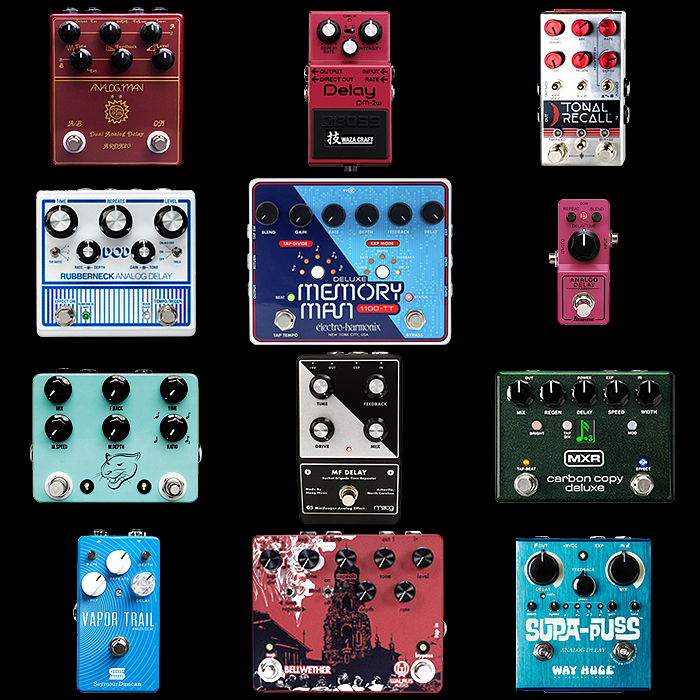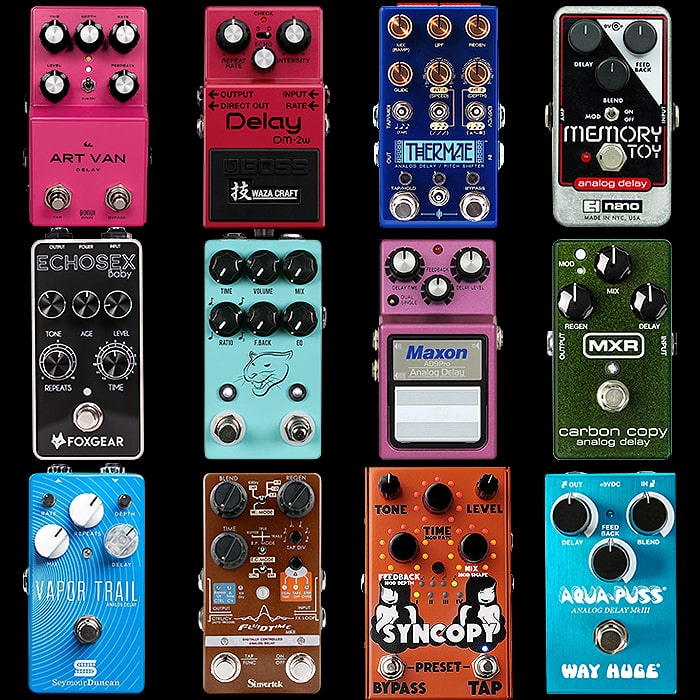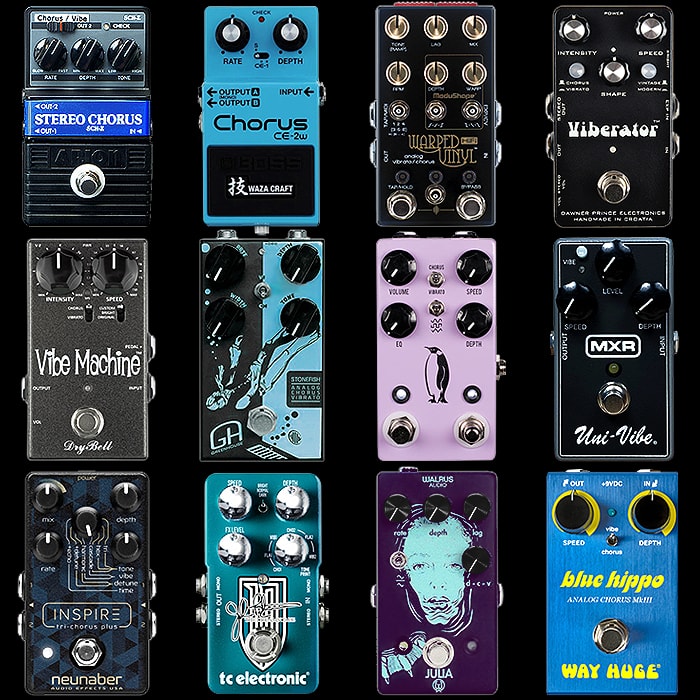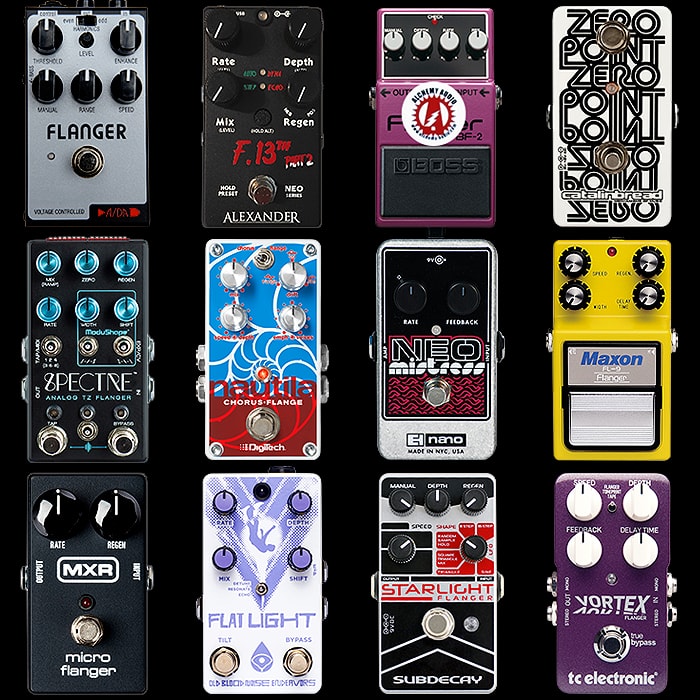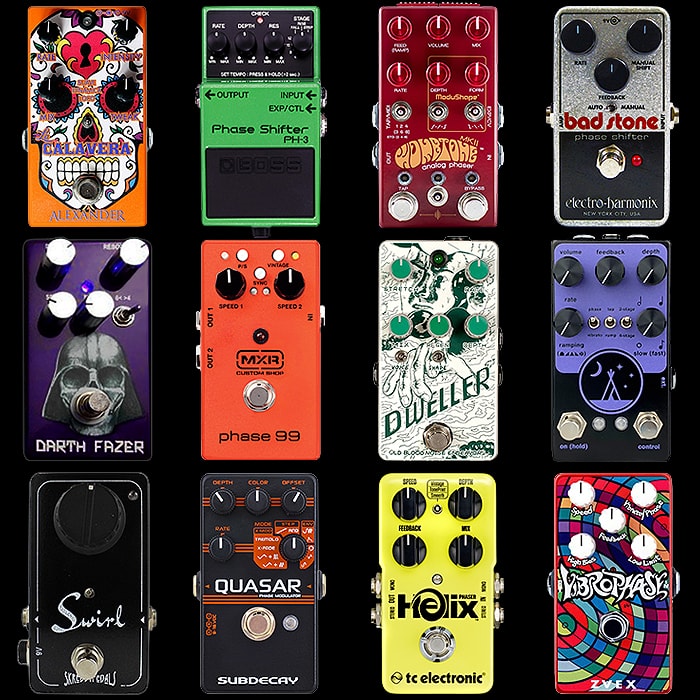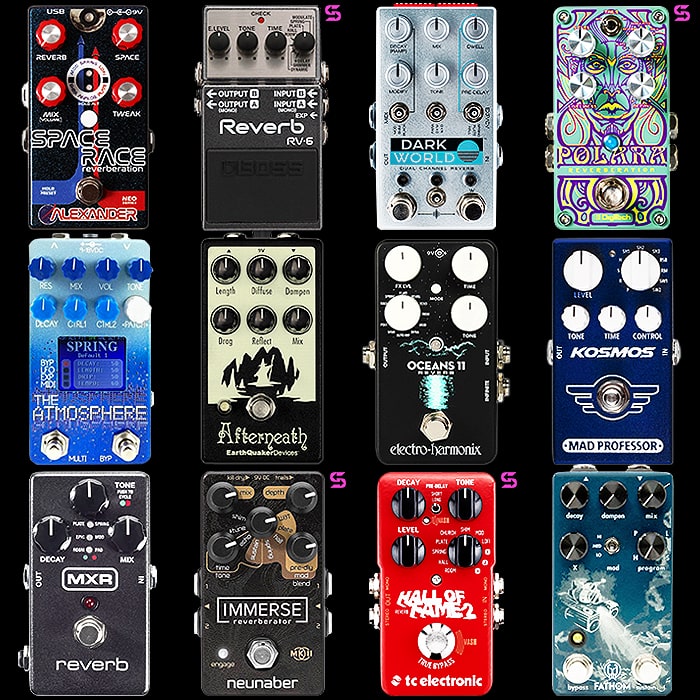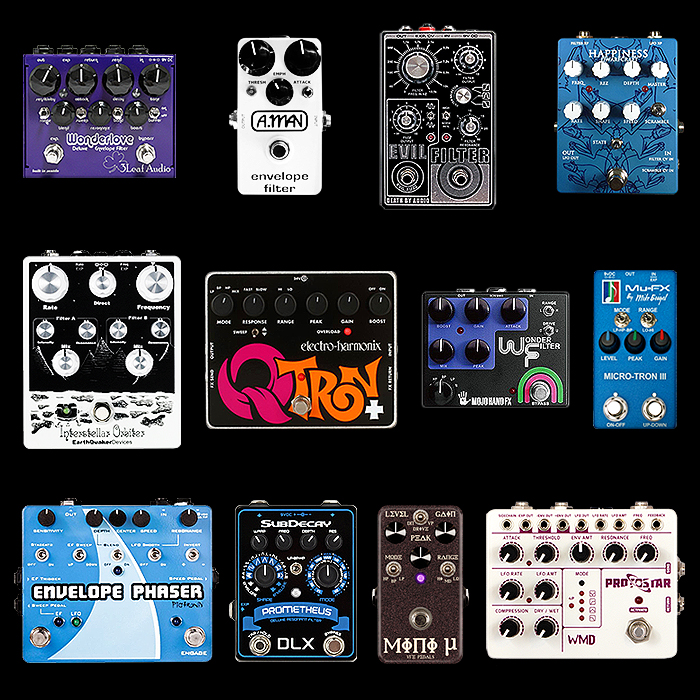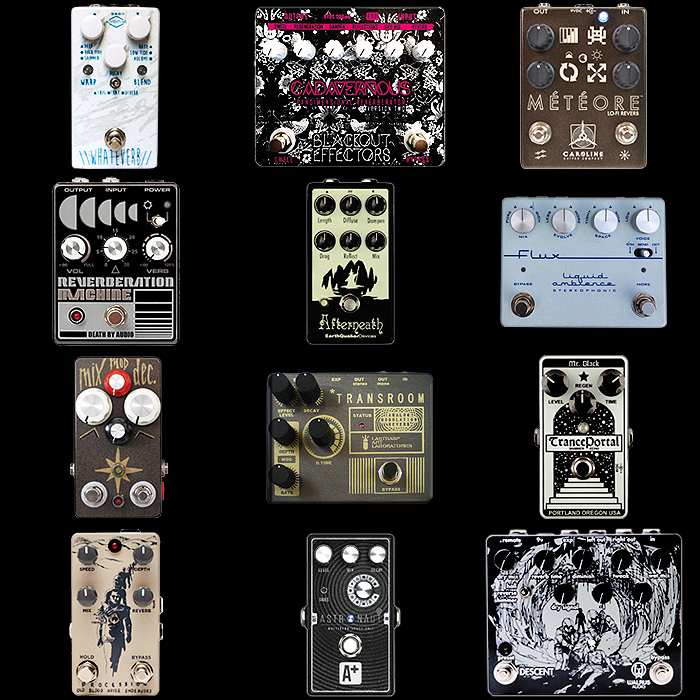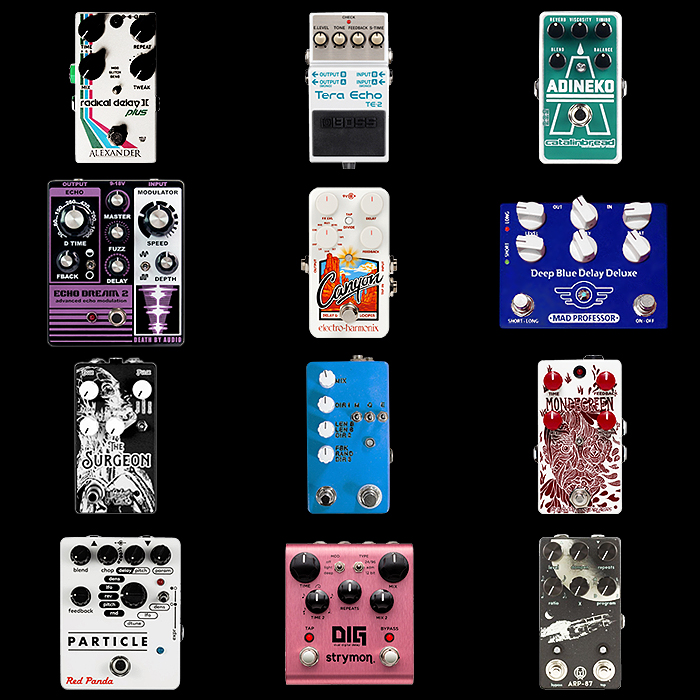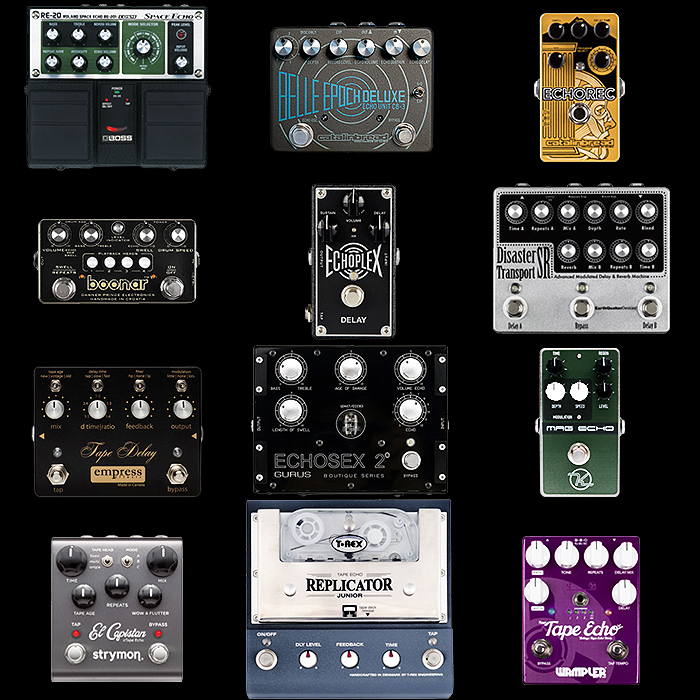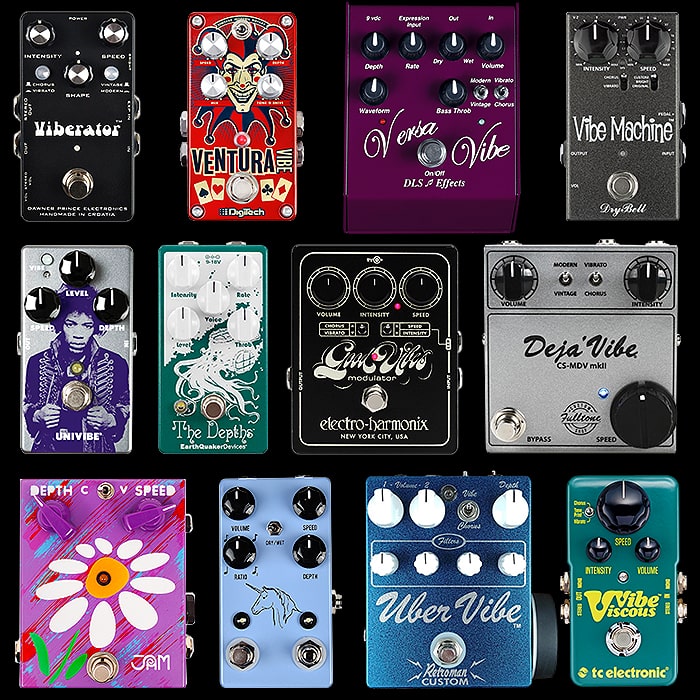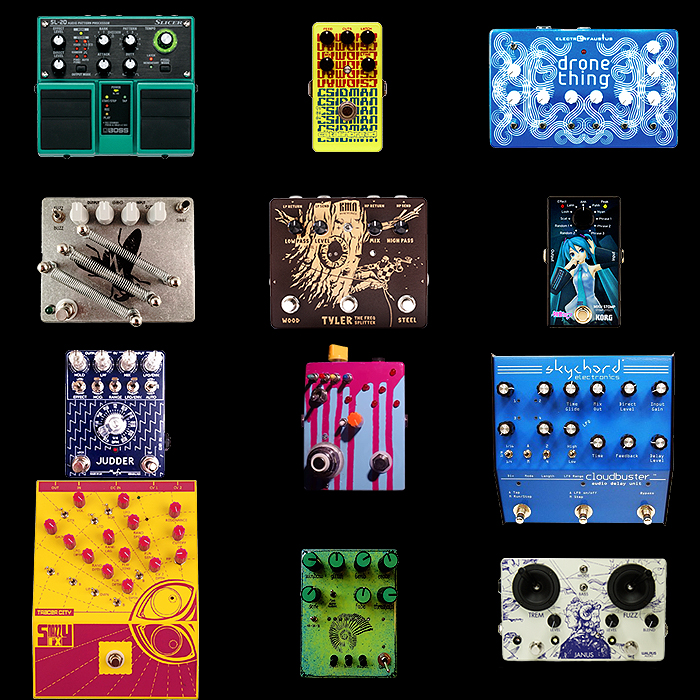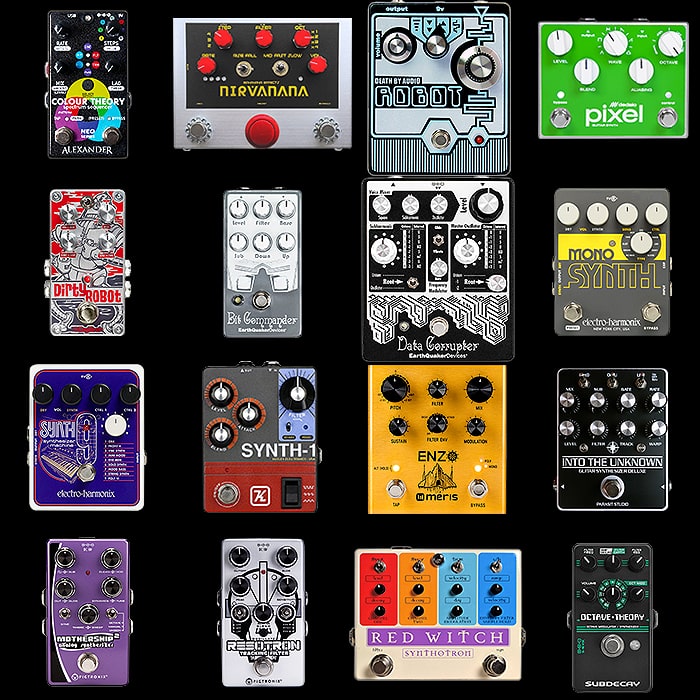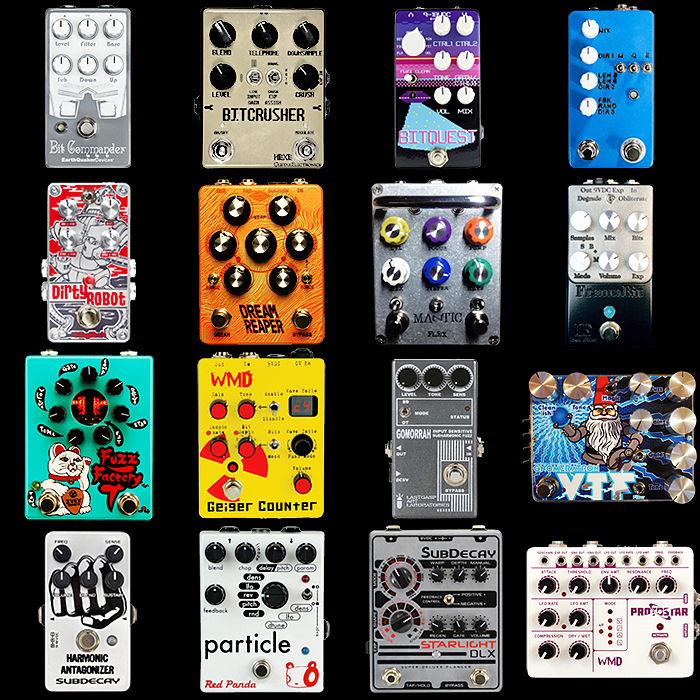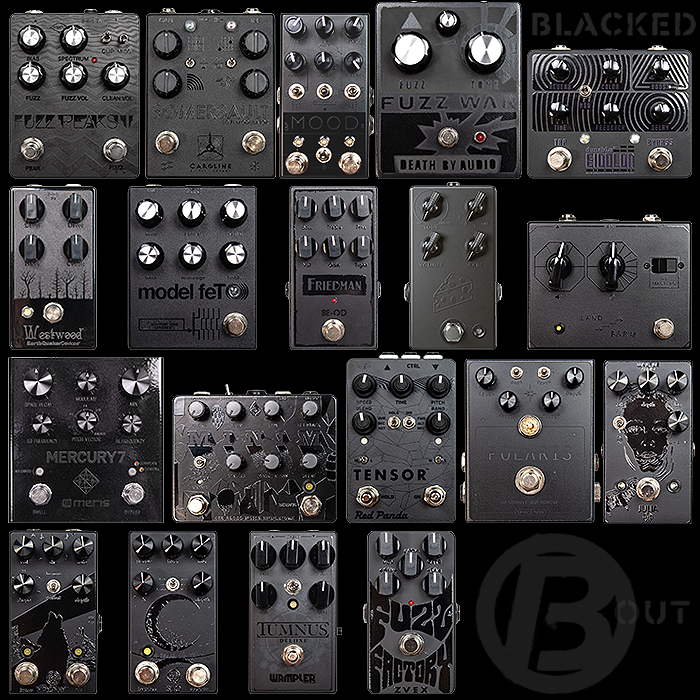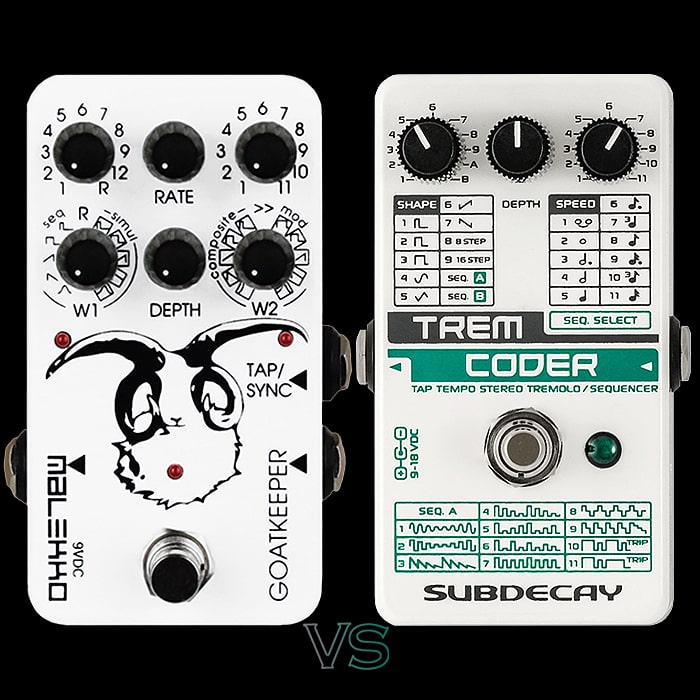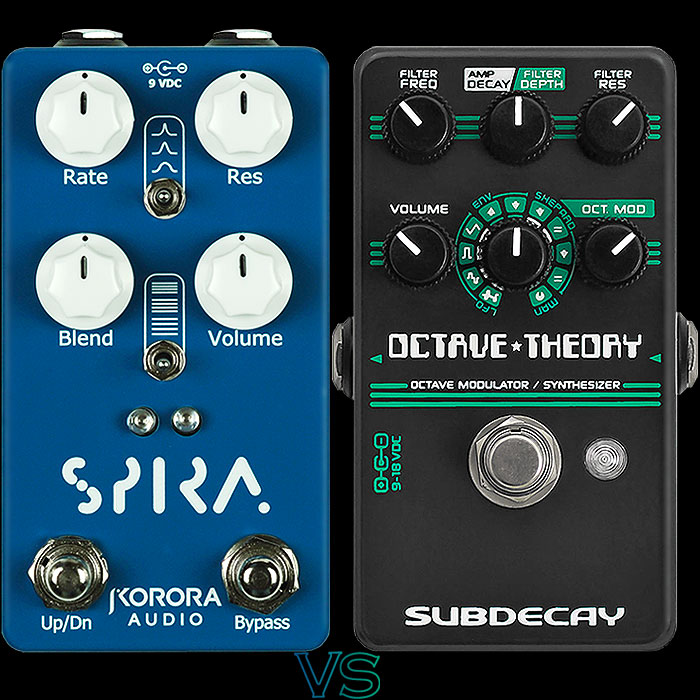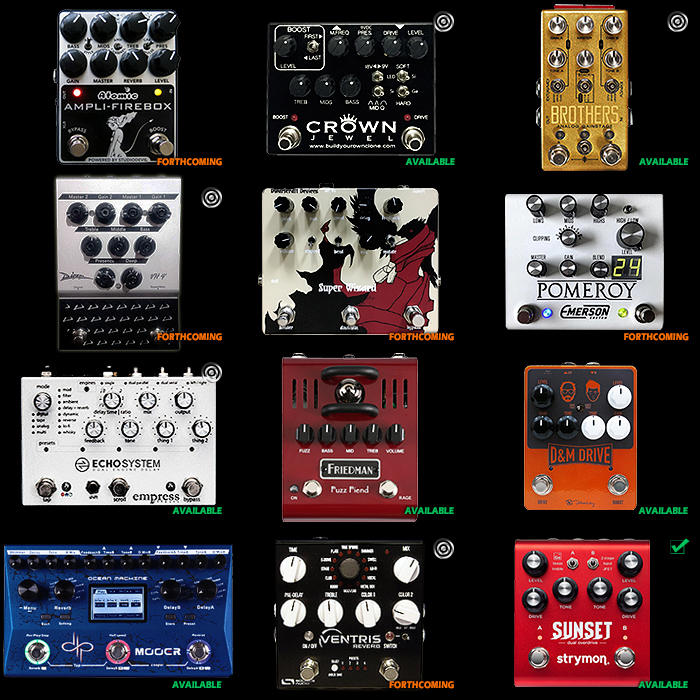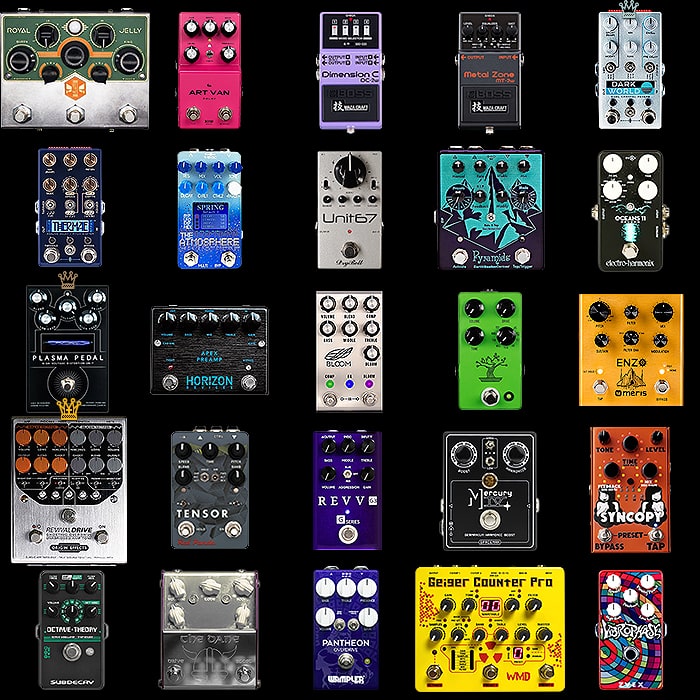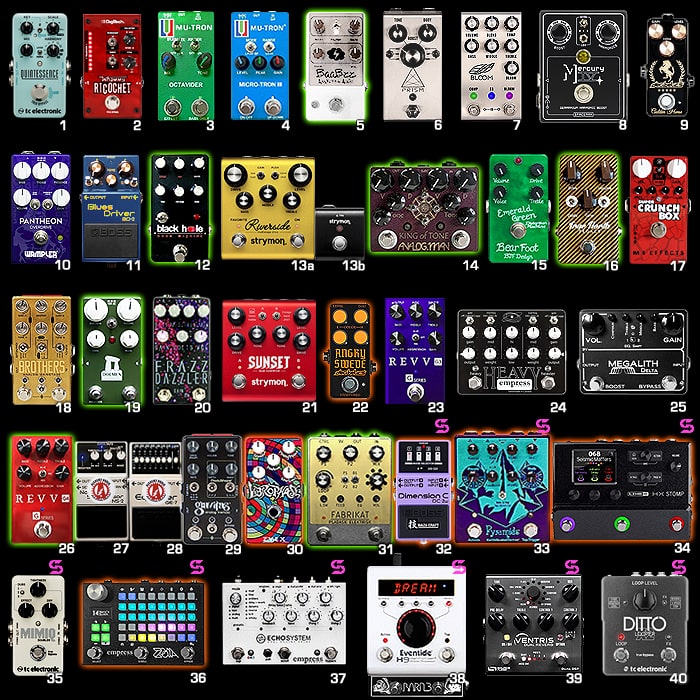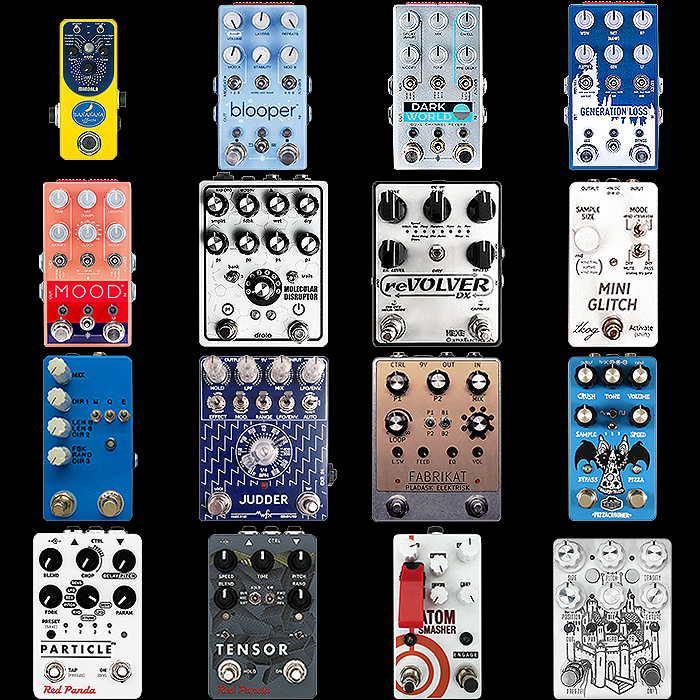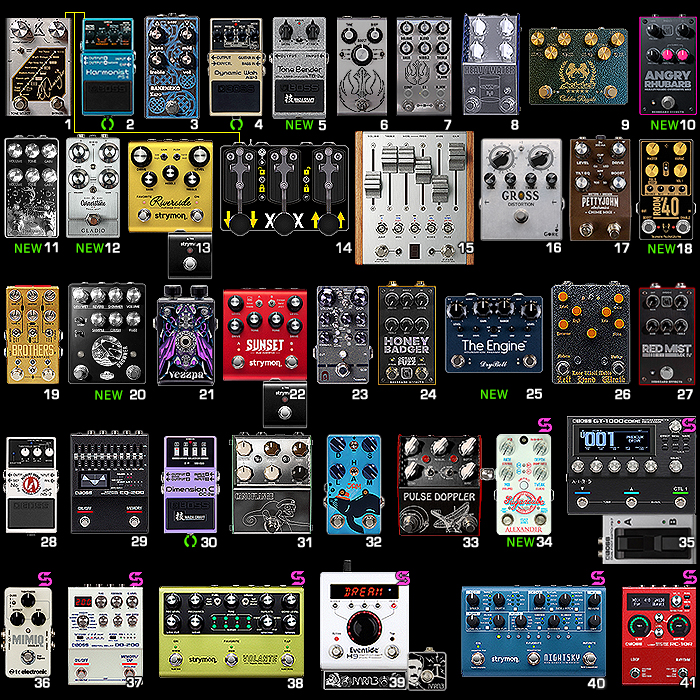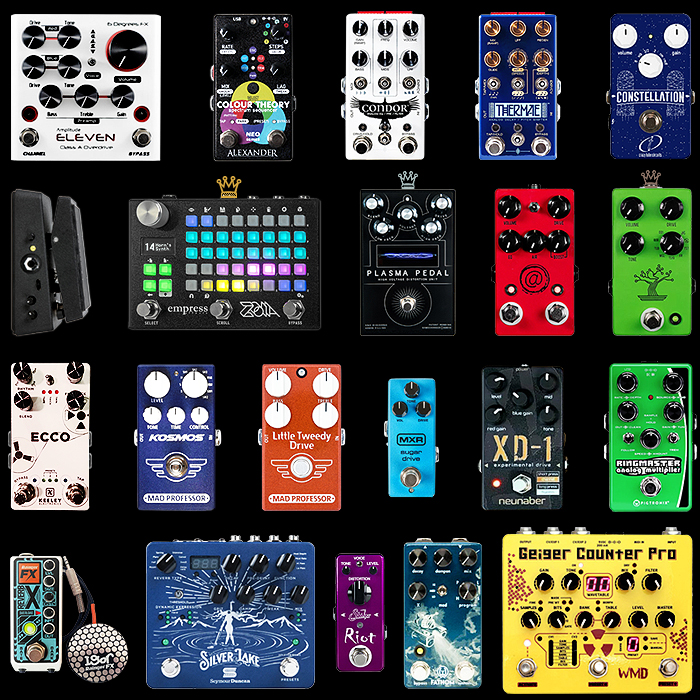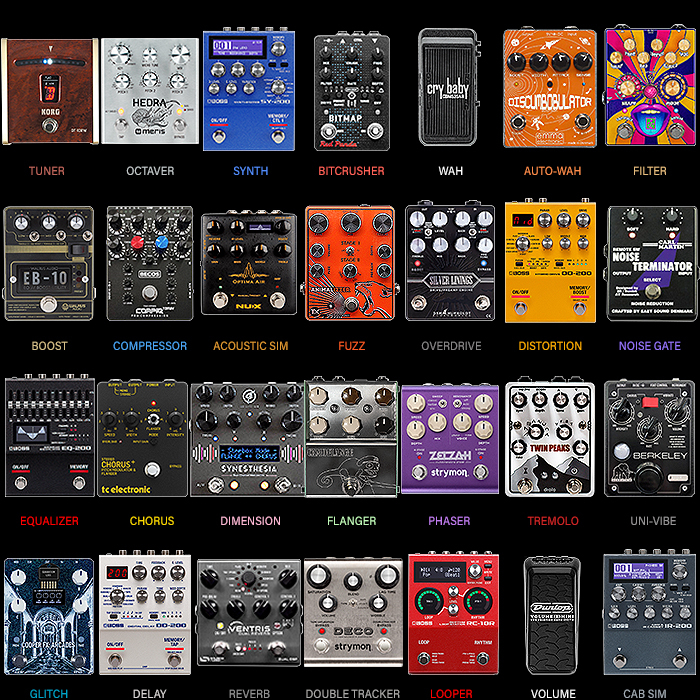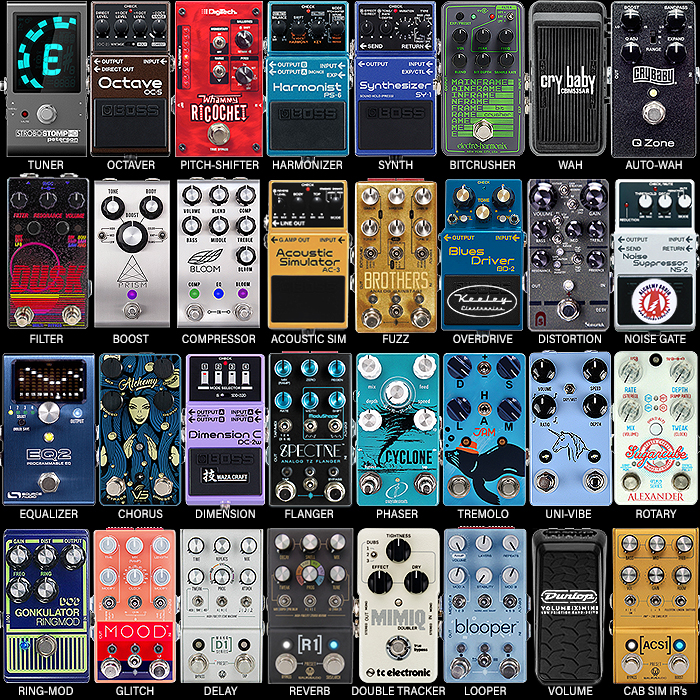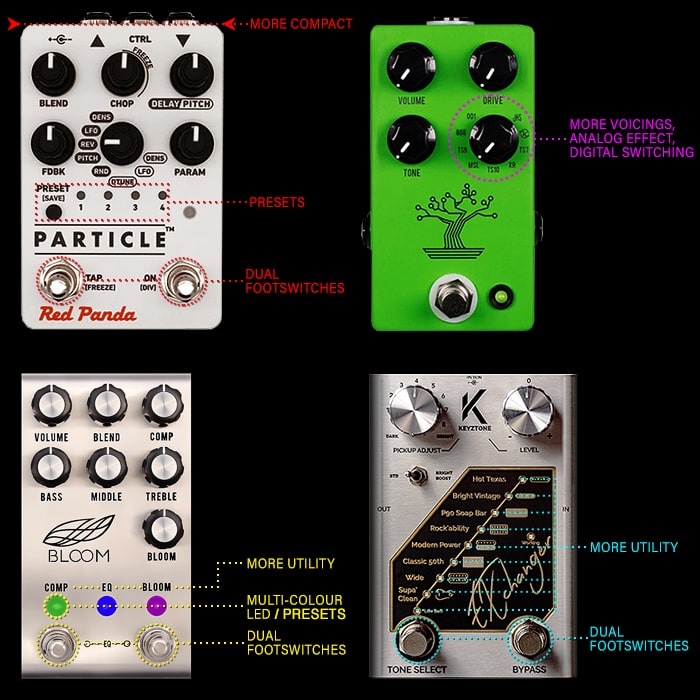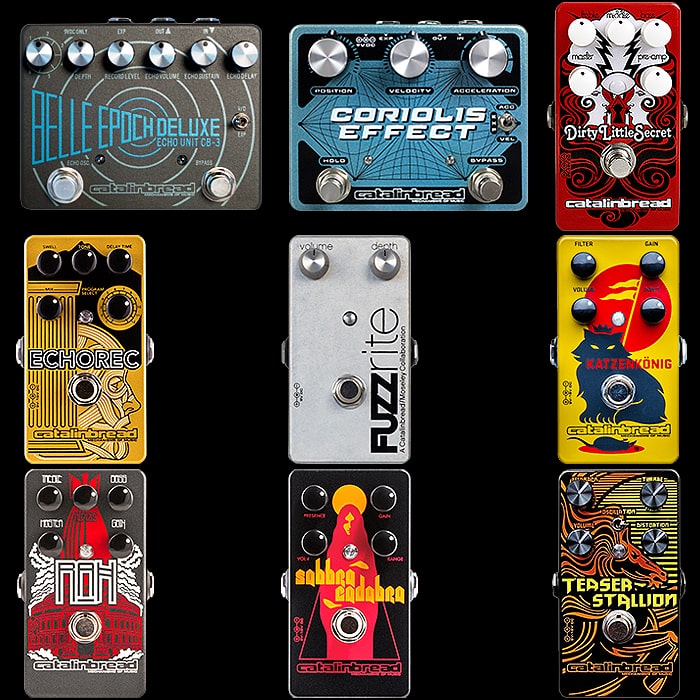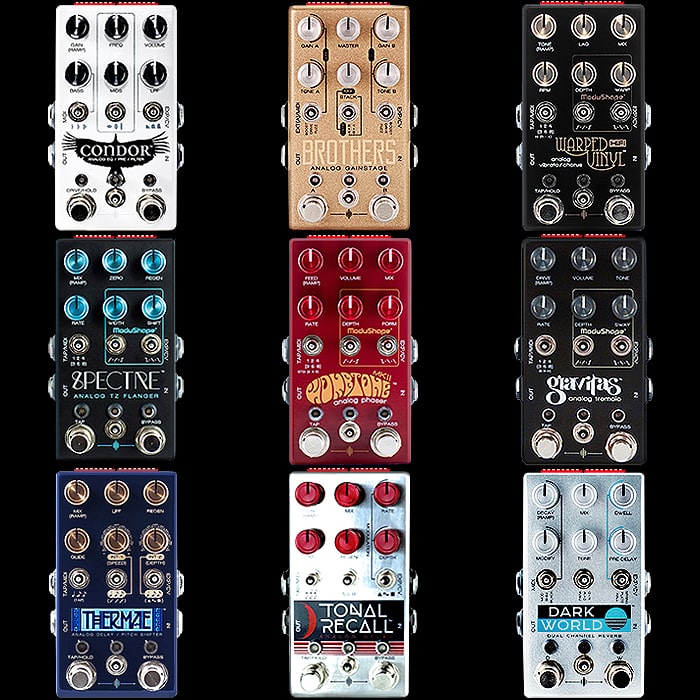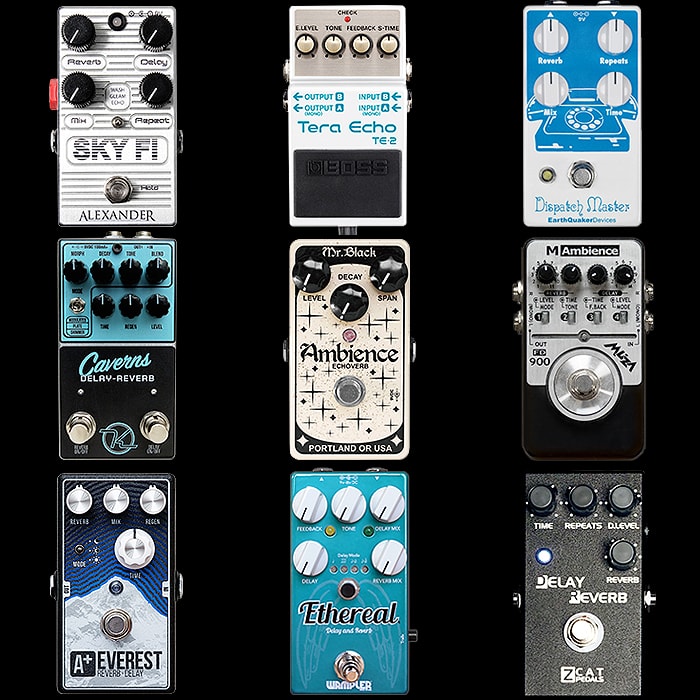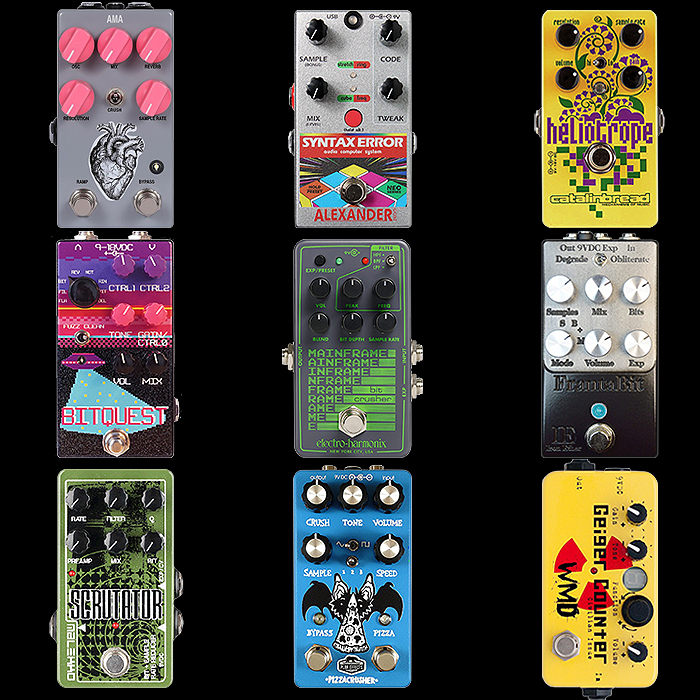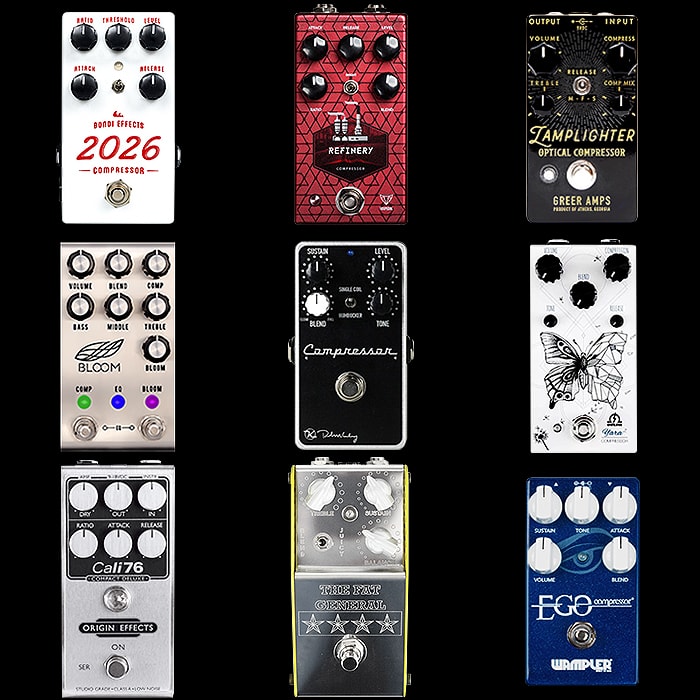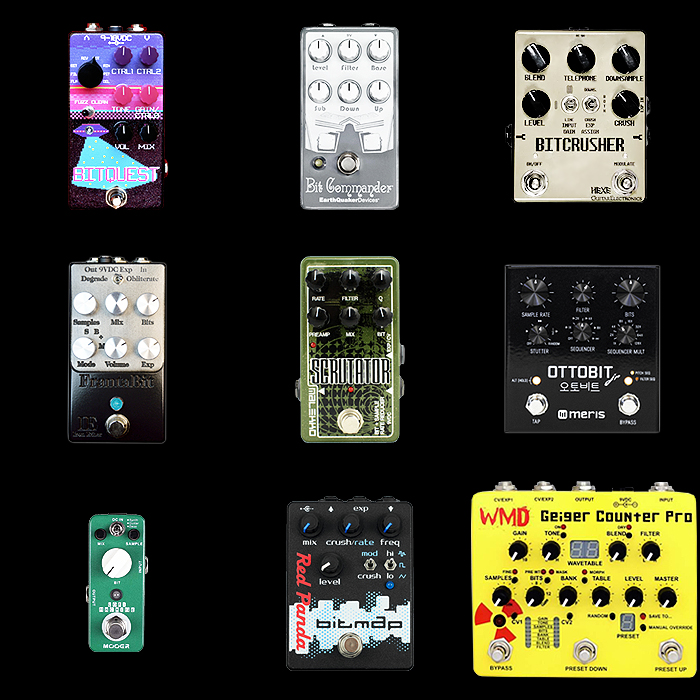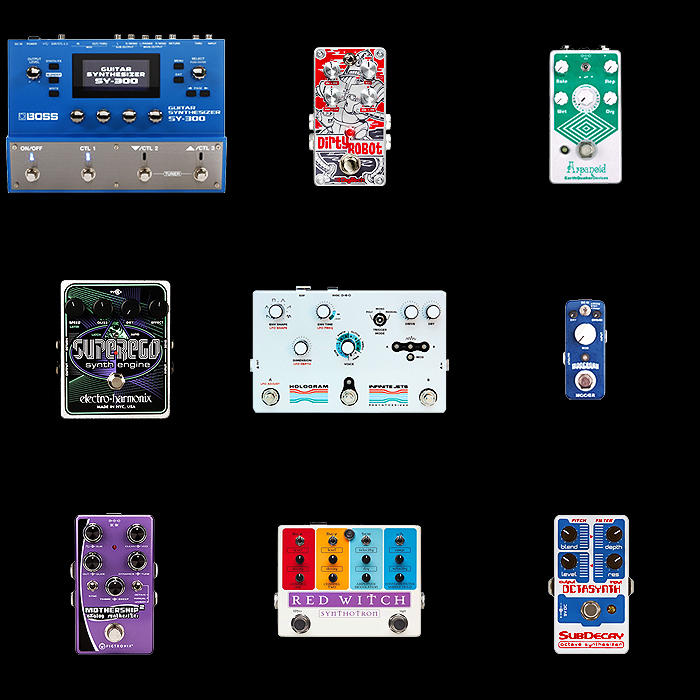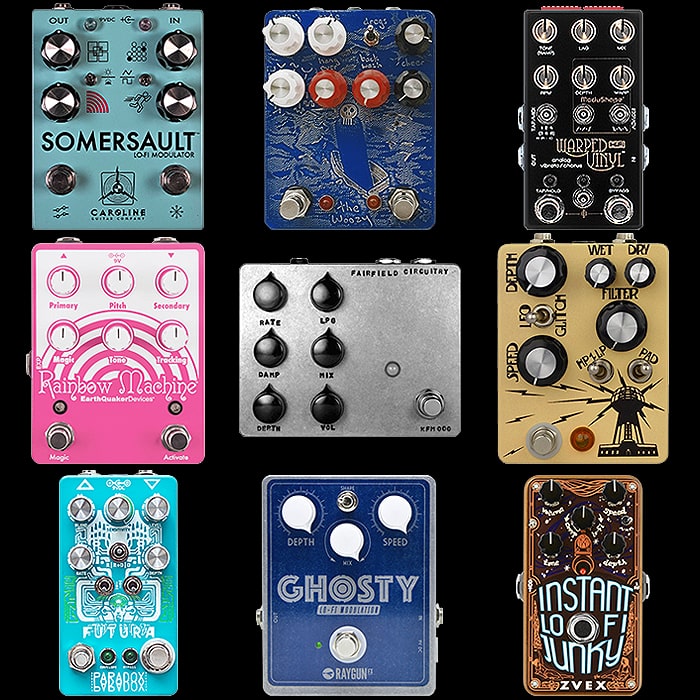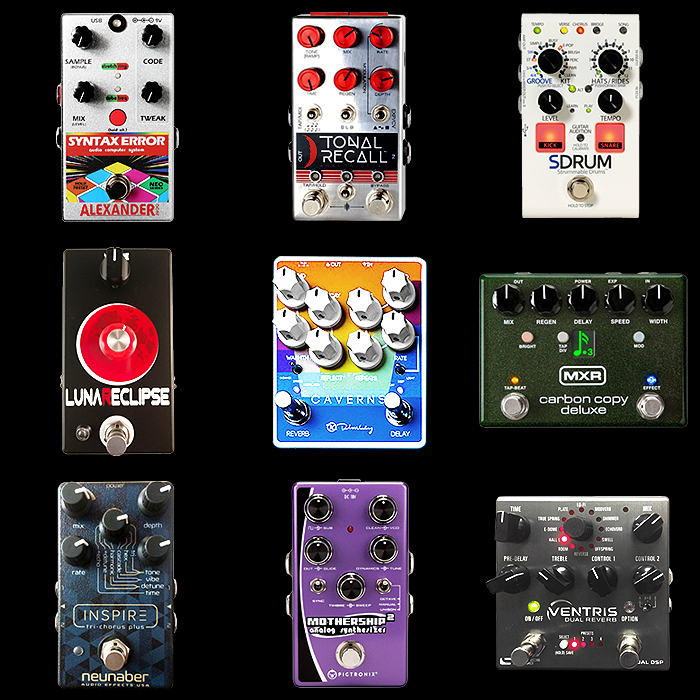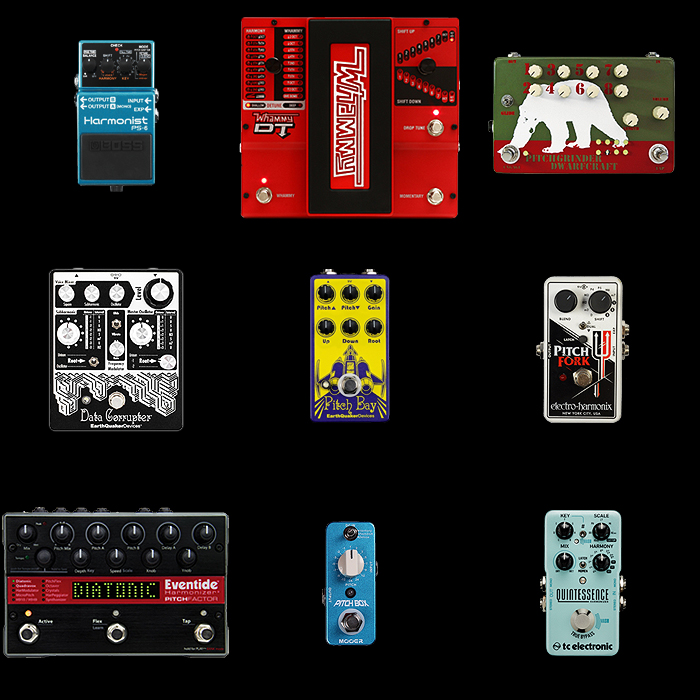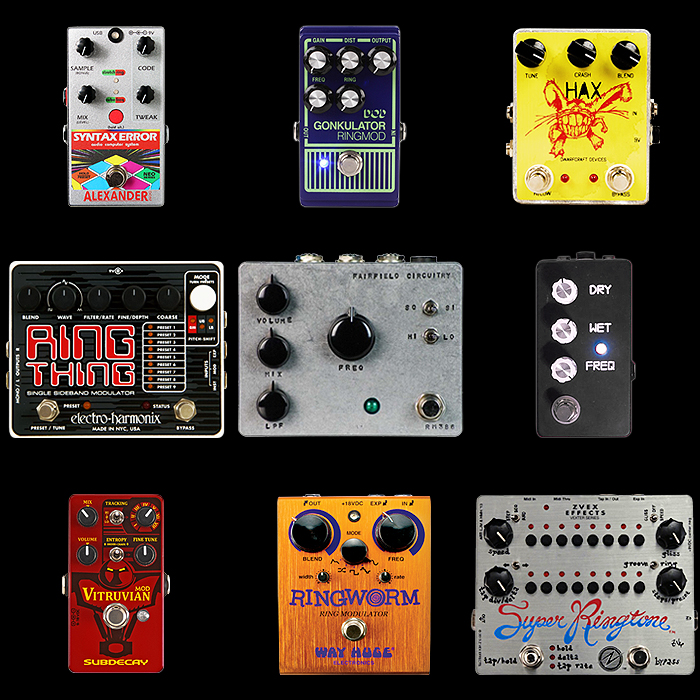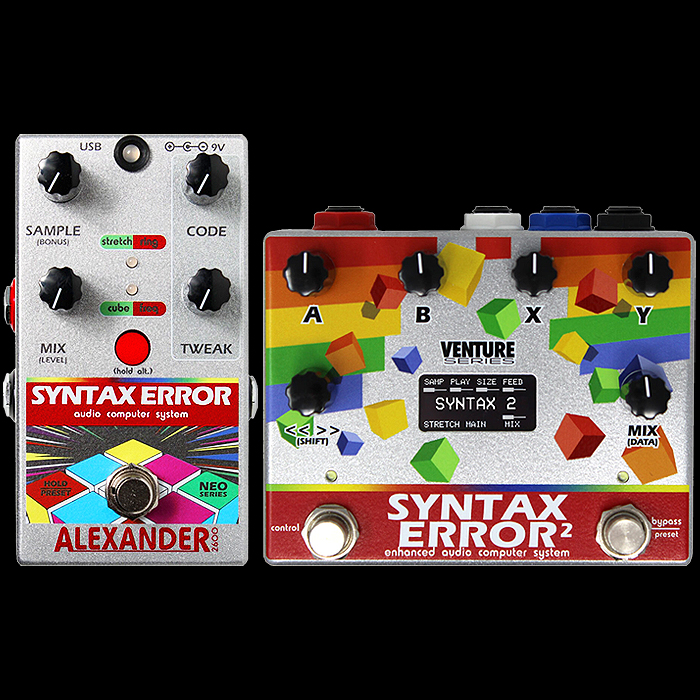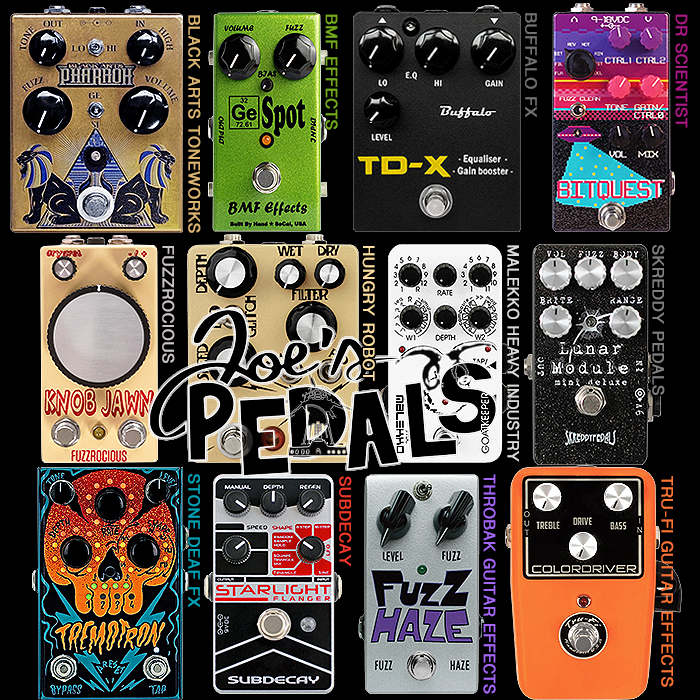16 of the Best Glitch Effects Pedals
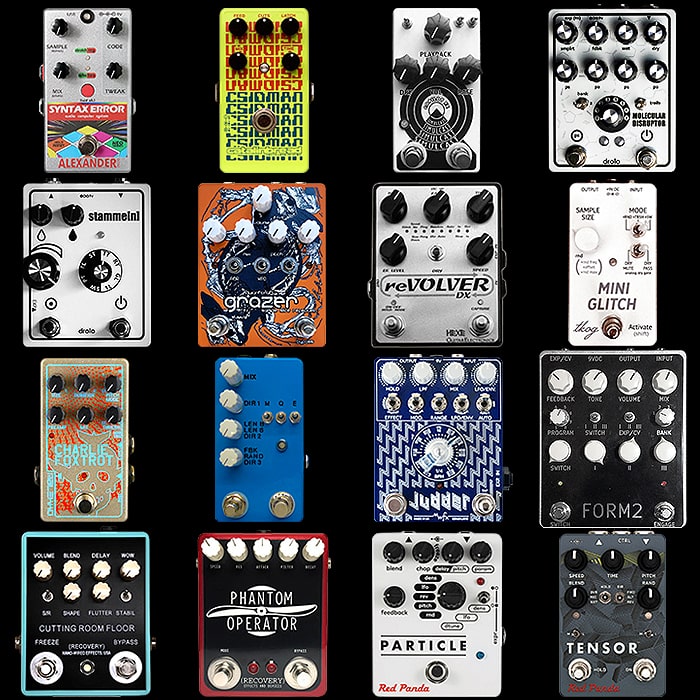
I’m sort of getting to full saturation point with drive, distortion and fuzz pedals - with my ’2018 Year of Fuzz’ coming to a close it’s time to direct my attentions slightly further afield and in new directions. I’ve always had an interest in sort of randomised textural effects - which means that my next significant area of interest will be that roughly defined by the category of ’Glitch’.
Most of the featured devices here are different types of micro sampler / granular (textural) looper - meaning samples of just a few seconds and less - which can be further cut up, reduced, stretched, ’mangled’ and the like for interesting punctuated playback variations. The pedals that I focus on can mostly / roughly be grouped into 4 sub-categories although some do a mix of all and more still:
- Granular Delay / Tape Effects
- Pitch Shifter
- Filter / Modulation
- Stutter / Slicer
Many of these use very commonly available chips like the Spin Semiconductor FV-1 Reverb Chip or PT2399 Delay Chip - both of those have a sample buffer at the heart of their operation - to which various other effects and modulations can be applied. There are a number of pedals here that I’ve featured before, and they range from single variable mode through triple mode - to as many as 32 possibly algorithms as in the case of the Pladask Elektrisk Form 2.
For taxonomy reason I’ve decided to exclude bitcrusher types - which my good friends at Delicious Audio though include in their 20 Glitch Pedal Overview. There is some degree of overlap here, and if you haven’t checked out their excellent roundup I recommend you read that first. My selections are always more personal / curated affairs where I only pick those pedals which appeal directly to me, and fit within my specific parameters and criteria - I could conceivably own all of the featured ones as I don’t recommend anything I don’t personally like to a degree, although there are some here which I am more likely to get than others.
The pedal here that’s been on my wishlist the longest is the Montreal Assembly Count to Five Granular Delay, followed by MWFX’s Judder - other pedals I’ve also featured before on this blog include the Alexander Syntax Error, Catalinbread Csidman, Dwarfcraft Grazer, Hexe reVOLVER, King of Gear Mini Glitch, and Red Panda Particle and Tensor - so I’ve had my eye on many of these for a while. In fact the only one I’ve acquired to date is likely the simplest one here - the rather cool Mini Glitch - I will not doubt add a few more in 2019.
I really like the look of he reVOLVER, but it’s in incredibly limited supply and really quite pricey - I also rather like the look of the Drolo Molecular Disruptor V3 which I have seen popping up on many a pedalboard, and the rather difficult to get Pladask Elektrisk Form 2. Recovery Effects also makes some really cool Glitchy effects, and we must not overlook Malekko’s Charlie Foxtrot or Copilot FX’s possibly now discontinued Simulcast - there are a few still available on Reverb.com.
A lot of these pedals are highly quirky, and some are inherently complex to operate - and much like my Empress EchoSystem - need a manual or guide-sheet handy - so you know how to apply the relevant parameters per algorithm. So funnily those pedals here that appeal to me the most are largely at either end of the spectrum - either the simplest or the most complex.
I still feel that the ’Glitch’ genre is rather in its infancy, and some more capable pedals with more useful displays and controls will evolve over time - which allow you to sample, chop up, re-arrange and texturise in every conceivably manner - individually and in combination - those will appear over the next couple of years or so.
Pedals are listed / pictured alphabetically by brand:
Alexander Pedals Syntax Error Audio Computer System (Stretch/Filtered Distortion/Ring Modulation/Frequency Shift) - £199
This was one of the first NEO Series pedals from Alexander, and I believe I initially included this in my Ring Modulator overview as it does have that flavour amongst its 4 modes. In fact the Syntax error covers a lot of 'Glitch' ground as you can see by its included modes.
- Stretch : adjust sample playback, reverse and add feedback
- Cube : cubed cascaded distortion with resonant low-pass filter
- Ring : ring modulation combines with sample and hold LFO
- Freq : frequency shift plus delay
There are 4 dial controls - Sample, Code, Mix, Tweak, and 2 have alternative parameters accessed via Alt button, as usual we also have 4 presets onboard for a really neat compact glitch pedal. I foolishly keep overlooking this one - but it's a pretty cool introduction to some of the key varieties of Glitch. Definitely one to consider.
Catalinbread Csidman Glitch Stutter Delay Pedal - £161
This one has been featured in the 12 Unique and Unusual Guitar Effects, as well as mentioned in a couple of my delay overviews. It's a really cool and unique randomized CD playback skipping / stutter delay effect - with delay time of up to 725ms, and with % dry 'Mix', 'Feedback' control, 'Cuts' for buffer memory length (degree of sample length) and and 'Latch' for relative time of sample buffer playback up to 100% vs non-skipping sample state.
This really has just a single variable mode and is one of the simpler pedals on offer here. As odd delays go - I much prefer Catalinbread's other slightly odd Bicycle Delay - and would choose other pedals which have a skipping style effect within their wider bank of algorithms.
Copilot FX Simulcast Micro Sampler Glitch Stutter Pedal - £102
Copilot is based in the Dominican Republic and has a pretty sizeable range of effects including this Glitch/Stutter pedal. It features 3 toggle switches - immediate playback or after sample recording, whole or part of sample via rate control, recorded playback or variable playback via 'Playback' (pitch) control.
The 4 dials are - Playback, Dry (%), Volume, Rate, and there are 2 footswtiches - one for bypass/record and the other for loop/stutter mode selection. This is another pretty neat and rather simple glitch pedal which I can see myself acquiring if the price is right. Since the time I started writing this up there are just a couple now available - it's not quite at the top of my list of acquisitions but I will snap one up if the price is right.
Drolo Molecular Disruptor V3 - €260
And then onto one of the more complex ones - I've seen these pedals appearing with increasing frequency on a number of player's pedalboards and often wondered what they were. They are actually made by David Rolo (DRolo) of Belgium and are in fact Multi-Effects pedals with 2 swappable modules which make up 2 banks of 8 algorithms / modes each. Meaning that you have the possibility of 16 different modes.
Currently there are 33 different Algorithms available - which you need to advise David on which ones you want when you buy. You can re-program the existing modules or order further ones - but you would typically need to send them back to David for this - so you need to do some serious due diligence in advance of purchase - to ensure you get the Algorithms best suited to what you need.
The 33 Algorithms as split across 6 categories :
- Delays
- Loopy/Samply/Freezy Stuff
- Glitch/Noisy/Random
- Modulation
- Filters
- Other (Tannhauser Gate, Hounds Synth, Drones)
You also get 9 dials - smplrt (Sample Rate), fdbk (Feedback), wet, dry, parameters ps, p0, p1, p2 per mode, then 0-7 mode dial, bank 1-2 switch and trails on/off switch - along with ByPass and Parameters Footswitches. Of course each mode will use the parameters differently.
For my own preferences I would have my 'Glitch' bank populated as follows:
- Glitcholay
- Granpa's Vinyl (lo-fi crackles)
- Pitch-Glitcholay
- Pitch Square LFO
- Pitch Step Glider
- Step Filter Bit Crushed
- Stretcholay
- Tannhauser Gate (Bitcrusher/Pitch-Shifter/Filter/Reverb)
With the second bank made up as follows:
- Drones
- Enveloop Vibrato
- Enveloop Reverb
- Envelope Filter Ring Modulated
- Hold Aliaser
- Hounds Synth
- Particolay
- Tape Loop
There are of course slightly more vanilla algorithms on offer too - but I would need the addition of a 3rd bank / module for those really. This pedal is currently sold out as they are manufactured in very small batches - so much like with many of these - you need to be subscribed via email and social media and quick to put in an order when a new batch becomes available. These are also prone to variations and updates. I really rather want one of these - I'm not sure whether I would need both this and the Form 2 even though they do have sort of different algorithms - having both would be something else actually!
Drolo Stamme[n] (Stutter) - €250
This is David Rolo's other sort of Glitch pedal - a collaboration between David and Kent Sommer (aka UglyCasanova) - actually a micro sampler/looper with multiple modes and the sample size controlled by tap-tempo.
When compared to the Molecular Disruptor - this is much the simpler proposition, albeit David has discontinued this current version with a note to say that he's working on a new edition - so will be interesting to see whether we get more banks etc. For now you get 4 dials - two smaller up top - Dry and Wet, then two larger ones - Control and Mode, with twin footswtiches - Function and ByPass respectively. The above video gives an excellent demonstration of this pedal's 8 modes:
- TT (Tap Tempo) : Bypass switch starts the loop, function switch taps the tempo
- RT (Random Tempo) : Each time you hit Bypass switch the loop starts with different random tempo, function allows you to gradually de-tune and degrade ongoing loop
- GL (Glitcholay) : Sample size randomly changes and randomly loops, the Function switch (momentary) adds feedback with octave up pitch shifter
- TL (Tape Loop) : 1 second tape-style loop which can be speed adjusted via control knob - in middle position loop runs at recording speed, Function switch (momentary) can loop current sample
- SW (Swell Hold) : Bypass starts the effect and freezes ongoing sample, Control knob defines how fast held sample fades in/out, Function switch can add another layer of audio or change sampled audio without stopping previous one
- PT (Pitch Hold) : Bypass starts effect and freezes ongoing sample, Control knob detunes signal counter clockwise (tape slow-down), Function switch can add another layer of audio or change sampled audio without stopping previous one
- FL (Filter Hold) : Bypass starts effect and freezes ongoing sample, Control knob goes from a low pass filter on the left to a high pass filter on the right, Function switch can add another layer of audio or change sampled audio without stopping previous one
- ST (Stutter Hold) : Bypass starts effect and freezes ongoing sample - stuttering like random step tremolo, Function switch (latching) applies stutter to dry signal too.
I'm not sure you would want both this and the Molecular Disruptor above as there is some degree of overlap here - I guess it depends whether you want a more complex or simpler pedal. As a 'Tweaker' I would go for the Disruptor, but I can see how many would prefer the comparative simplicity of the Stamme[n].
Dwarfcraft Grazer Sample Slice Repeater - £199
I think I've mentioned this one once or twice in passing on this blog, but this is a really neat version of the more typical sample / slice / repeat type glitch effect. It is in fact a rather capable micro sampler / looper with both manual and automated sample 'Grab' and Mix, Pitch and Size controls alongside Auto Grab Cycle Speed, Expression control of Size or Pitch, and Forward or Reverse sample playback - actually a really instinctive and simple to use micro sample granular looper!
I would personally prefer it if it was in a slightly more compact enclosure - and for this particular form factor there are a number of pedals here that do quite a bit more, but for what it is it's pretty solid for what it delivers. Not necessarily at the top of my wishlist, but deserves consideration.
Hexe Guitar Electronics reVOLVER DX (Randomized Skipping, Tape Effect and Drone) - €400
This is a pretty cool but rare Glitch pedal which is very much in demand. You need to contact Piotr Zapart through his site (Here Guitar Electronics), and I believe there is a waiting list of a year or more for these. When they do occasionally appear as second-hand on Reverb.com they are of course snapped up very quickly so you need to have your alerts in place! Be aware that there are several editions of these too.
The controls are relatively simple with 5 dials for - Tone, Fade, Time, Effect Level and Speed, and a Dry on/off switch. You get dual footswitches On/Off and Capture - and you hold down the former to switch / step through the 8 available modes:
- Glitch : momentary 'Capture' footswitch action
- Speed Up/Slow Down
- Ping-Pong : play direction is flipped at the end of the sample
- Random Direction : play direction is flipped at random points
- Random Auto : pedal re-triggers itself at randomized rate
- Auto : automatic self re-trigger at a constant rate
- Stop - 2x : Halt / half speed - variable speed from 1 octave down (/2) through normal (dead zone) to 1 octave up (2x)
- 1x - Reverse : special mode for reverse effect. The speed goes from normal (1x) to 2 octaves down (/4), in the middle position the play direction is reversed, then the speed increases to normal (1x), still in reversed direction
There's no doubt that this is a great pedal of its type, but on a dollar to algorithm level there are better value pedals here, and I'm not convinced the hold-and-step-through approach is necessarily the best way to access the different modes - although you do get an LED display to show you where you're at. I like the look of this one, but it would probably come after the Pladask Elektrisk Form 2 and Drolo Molecular Disruptor 3 in the pecking order for me!
The King Of Gear Mini Glitch Pedal (Stutter) - c£165
The only one I own so far and in most ways the simplest of those featured here. It has 3 modes:
- RND (Random) : random glitch / stutter
- TRSH (Threshold) : starts new glitch sequence each time input signal threshold exceeds limit set by alt function on main dial
- SW (Switched) : random glitch / stutter activated by momentary or latched footswitch
There are also 3 alt functions 1 per mode, accessed by holding down the footswitch while using main dial
- Rnd Freq : frequency of glitch (RND)
- Offset : threshold level (TRSH)
- Rnd Max : max sample length (SW)
I rather admire the neatness of this pedal - which is a significantly simplified version of its 'Feral' predecessor and manages to cleverly combine the latching and momentary functions into the one single footswitch. Well worth seeking out.
Malekko Heavy Industry Charlie Foxtrot (Pitch Shifting and Stutter) - £189
This is a really neat and precise Glitch machine really - covering Pitch Shifting, Stuttering and Randomization thereof across 5 modes. You have 6 straightforward dials to operate with - Buffer/Grain 'Size' (200-600ms), Repeat 'Duration', Pitch Mode (Stutter, Pitch Up, Pitch Down, Pitch Up & Down Alternating, and Random application of 4 previous), PreAmp Level (Volume), Mix (Dry-Wet Mix) Threshold (from Auto-Capture to Manual).
It is the signature pedal for Peter Holmström of Dandy Warholm fame, and obviously useful in live playback situations as it is additionally highly controllable via expression pedal. You can assign any or all of Size, Duration, Pitch Mode and Threshold by holding the footswitch down and moving any of those dials - direction of dial movement affects direction of sweep on parameter.
Of course I like all the pedals featured here, but for the compacts would put the Mini Glitch, Count to Five and Syntax Error slightly ahead of this one for my particular needs, which means I likely won't be getting this one (unless at an amazing price) - but it's still a highly viable choice and excellent at what it does.
Montreal Assembly Count to Five - $250
Of all these pedals, the Count to Five has been on my wishlist for the longest time - I've made my mind up to acquire one when I get the next notification of stock. It's not surprising that this still remains highly popular and is still seen on such a wide variety of boards - as it mixes up its Glitch modes and functions so elegantly.
You have a Mix dial up top, and then 3 parameter dials - the first of which 'Direction' is constant for all modes, while the latter 2 change function depending on mode, we then have 3 toggle switches - M for Mode, Q for Quantization and E for Expression Pedal Assign:
- M = 3-way mode toggle
- Q = up-down toggle for 6 Quantizations - No Quantization, Chromatic Quantization, Whole Tone Scale Quantization, Diminished Triad Quantization, Augmented Triad Quantizaiton, Perfect Fifths and Octaves Quantization
- E = 3-way Expression Pedal Assign Toggle - Mode 1 (Direction, Length of Buffer, Feedback), Mode 2 (Direction, Length of Sample, Randomisation), Mode 3 (1, 2 or 3 read heads)
The 3 modes are as follows:
- Mode 1 - Delay : Direction & Speed of Read Head, Length of Buffer, Arount of Feedback
- Mode 2 - Slicing Looper (4 secs) : Direction (pitch, speed, direction), Length of Sample, Degree of Randomness
- Mode 3 - Layers (8 secs) : each of 3 main parameter dials controls 'Direction' per Top, Middle and Bottom
The right hand footswitch is known as the hard footswitch / ByPass, the left is the soft footswitch / trigger and alt mode selector as referenced in the manual / guides.
I have wanted this pedal for a long time, but whenever a buying opportunity has arisen thus far I've had other priorities - now I'm determined to acquire one. Montreal Assembly also makes the rather more complex '856 for Zellersasn V2' - which goes currently for around £440 on Reverb.com - there are currently 3 Mint or Brand New versions available. The Zellersasn is obviously a much more complex proposition with 8 dials and 8 toggles along with dual footswitches - I may consider that later on, but I'm more in the Count to Five camp at the moment - I am determined I will have one as soon as they're available again.
MWFX Judder - £250
This is a pedal I've featured a couple of times too, and is one of my 'must have' British-made pedals - which I have yes still to acquire. It is available in an alternative wooden enclosure edition, as well as in a mini - actually compact pedal version. However it is the original medium-size enclosure version I still like best with its extensive 5 control dials, 5 toggle switches and dual footswitches.
This is essentially a stutter effect at heart but with LFO and Envelope Filtering for enhanced modulation and sort of warbly texturisation. Part of me feels that all Glitch-type pedals need a specific 'Randomization' button which this one does not yet have - possibly future editions will have - which randomly mix up the effects and modulations.
5 Dials :
- HOLD : Feedback, Number of Repeats
- LPF : Low Pass Filter / Tone of Echo
- MIX : % Dry to Were Ratio
- LFO/ENV (: LFO Speed / Envelope Sensitivity
- 1/4 BPM : Length of Repeat with BPM Guide
5 Toggle Switches :
- EFFECT: Layer/Judder/Stutter (Sound on Sound or Killswitch Modes)
- MOD : LFO/Envelope Modulation of Sample Length / Pitch
- RANGE : Short/Long Sample Modes
- LFO/ENV : LFO or Envelope Controls
- AUTO : Turns on LFO/ENV Control of Footswitch
2 Footswitches:
- Lock : Latching / Direction of Tap Switch
- Tap : Momentary
This is one I'm definitely getting next year too - I feel 2019 could be my year of Glitch!
Pladask Elektrisk Form 2 (32 Pontential Modes) - NOK 2,500 (c£230) [BandOrg.no DIY Pedal Course) (or $300 limited edition?)
Of all the pedals featured on this page - this one is probably the most interesting overall. It started as a DIY Workshop Course created as a collaboration between Norwegian pedal-maker Pladask Elektrisk and community course organiser BandOrg.no - also Norwegian. The initially Form 1, and now subsequent Form 2 started of as DIY-enhanced editions of Pladask's slightly smaller Fabrikat pedal ($300).
Pladask at one time set that the only way to get the more substantial Form 2 was to do one of the Spring or Summer course organised by BandOrg.no - which means spending time in Norway - and several limits access to said incredible pedal. However this summer, Pladask announced that it would be making a run of 20 Form 2 pedals to be sold through its site - these were of course snapped up immediately. There is no indication as to whether this was a totally limited one-off exercise or whether it might happen again. Of course 'Knobs' famously did one of their fantastic videos for the Form 2 - as above, and I've seen versions of this pedal with a mix of white, black and red knobs - so numbers and distribution, intended and actual are rather unclear at the moment. Most 'Glitch' fans though are pretty desperate to get their hands on one of these - the Form 2 actually comes with 24 algorithms across 3 banks, with a further 8 empty slots, while the more compact and very slightly simpler Fabrikat has 16 algorithms - which is the same number as the Drolo Molecular Disruptor above.
Here are the modes across the 3 banks, maximum buffer size is pretty universally 1000ms:
Bank 1 :
- Time Stretch with Buffer Size
- Time Stretch with Pitch Shifting
- Time Stretch with Grain Size
- Time Stretch Pendulum with Grain Size
- Time Stretch Random Pendulum
- Freeze/Scrub with Spread
- Freeze/Scrub with Pitch Shifting
- Beat Repeater
Bank 2 :
- Sample Playback - 1 Head Manual Sweep
- Sample Playback - 1 Head Octave Steps
- Sample Playback - 2 Heads Manual Sweep
- Sample Playback - 2 Head Octave Steps
- Sample Playback - 1 Head Random Octave/Direction
- Shuffle Delay
- Shuffler
- Shuffle/Mask
Bank 3 :
- Single Sideband / Ring Modulator
- Sample / Hold Lowpass Filter
- Random Vibrato
- Tape Delay Simulator
- Texture Reverb
- Octave Reverb
- Octave Generator / Delay
- Pitch Tremolo
Bank 4 : Currently Empty / Clear
(smaller Fabrikat contains Banks 1 & 2 only)
The 10 dials and 2 toggles of Form 2 are as per following sequential order: Feedback, Tone, Volume, Mix, Program 1-8, Switch Toggle I/II/III, Exp/CV Toggle I/II/III, Bank 1-4, Switch Level, Param/Prog I, Param/Prog II, Param/Prog III.
For the dual footswitches we have Switch + Engage
In most ways the Form 2 is not too dissimilar a control topology to the Drolo Molecular Disruptor above - and both have algorithms in banks of 8 for some reason - indicating similar chip-sets? In any case - this is also one of my targets - seeing as you can cram 32 algorithms onto one of these pedals - and if it's similar to the Drolo, then there's probably some way to swap and update modules too. We'll see what evolves next year and whether these are made available again outside the course programme. I definitely want one though - please hook me up Norwegian cousins!
Recovery Effects Cutting Room Floor (Echo/Pitch/Modulate/Glitch) - $199
This mixes up a number of the more typical Glitch elements - Delay, Pith and Modulation - in the same Sample / Repeat / Hold / Freeze manner that many here do. It's more of a fluid modulation of a singular but compound type of effect versus the several here that have distinct different modes.
In some ways there are some palpable similarities in tape-manipulation-effect dynamics between this one and the Red Panda Tensor featured later.
The 6 dials then 2 toggle switches are as follows : Volume, Blend, Delay (Time), Wow (Modulation), Shape (Triangle/Square), Flutter (Speed of Flutter), S/R (Single/Repeated Delay), Stabil (Flutter On/Off). And the two footswitches are Freeze/Engage and ByPass/On.
This pedal is more on par with something like the Grazer here, and can't compete with the more advanced pedals which have multiple modes and algorithms, but what it does it does really well. This is much more than an also-ran, but with some very strong competition in this overall group though.
Recovery Effects Phantom Operator (Supernatural Random Flux Filter) - $199
Although different in its outcome, this pedal shares some degree of similarity with the MWFX Judder, while the emphasis here is more on the warbly filtering, and you don't get near the same sort of harder stutter or judder of the MFFX one, but the filter engages fairly similarly.
You have a relatively simple control topology with just 5 dials - Speed (Sample/Hold Speed), Res (Filter Resonance), Attack (Speed of Filter Onset), Filter (Filter Frequency), Decay (Filter Decay). And while the right hand footswitch is ByPass / Engage, the left hand 'Mode' footswitch toggles between VCF and Sample/Hold Modes.
For a rather simple pedal it still generates some really cool Glitchy textures per the above demo. Possibly its appeal is somewhat limited within the scope of what some of these others offer, but you have to admit that it does create some rather excellent Glitchy tones.
Red Panda Particle Granular Delay / Pitch Shifter - £265
I've always viewed this Granular Delay sort of hand-in-hand with the Count-to-Five - as its sort of bigger brother, with a few more tricks up its sleeve, but delivered in a slightly different manner. You have 8 modes here over the 3 of the Count to Five, and near enough the same controls, but only the one footswitch. Whenever I look at the two of them, I'm impressed by both, but lean towards the more compact dimensions of the smaller blue pedal.
The 8 modes of the Particle are :
- 5 Delay Modes - Random, Density, LFO, Random Pitch, Reverse
- 3 Pitch Modes - Detune, Density, LFO
The Particle obviously has the Pitch-Shifting over and above the Count to Five if that matters to you - and the output ranges from radical pitch and delay modulation to shimmering repeats to stutter/glitch sounds. Overall this is the more capable pedal, but there's just something magical about its smaller competitor that draws me to it.
Controls include - Blend, Chop/Freeze, Delay/Pitch, Param, Feedback, Mode Dial, Expression Assign - Density, LFO, Detune.
I think this is well worth having if you prefer it to the 'Count to Five', but I'm not sure you would necessarily want both of them - although I have seen that done too! Just as I've seen a few boards with 2 Count to Fives on them.
Red Panda Tensor Looper/Time Stretcher/Pitch-Shifter - £295
I've touched on this one before, and included it in my 2018 Pedals of the Year, and it share some superficial similarities with the Recovery Effects Cutting Room Floor - which is also a kinda sorta tape-delay-manipulation effect.
More accurately, this is a sort of tape-style hold and modulate effect with Speed, Time, Pitch, Blend and Randomisation dials - along with Overdub/Replace/Next Loop Hold options and Forward/Alternating/Reverse Direction options.
Footswitches can be Momentary or Latching, time stretching in 4:1 ratio, Pitch-shifting of -2 to +2 octaves.
I would probably take this over the Cutting Room Floor, but it's not quite up with some of the more higher priority ones here for me.
Final Thoughts
This can be a tricky area to get into, and there is a significant learning curve on many of these pedals (along with cost and availability challenges), which will no doubt put many players off - even though I have featured most of the simpler ones here that are fairly straight-forward to get to grips with.
I have always admired the 'Knobs' YouTube Channel - and many of these pedals happily live within that environment. Several here are both very hard to get hold of and likely prohibitively expensive for some. With many of these though - if you don't get on with them they are relatively easy to shift - unless you get overly greedy.
Where I am within all of this is one down and probably 3 or 4 more to go. In the following most likely order - but depending on what becomes available when. Actually, even though the Count to Five is my most wanted here, it is unavailable for long periods - so I will likely acquire the Judder first, I also really like the look of the Drolo Molecular Disruptor V3+ and the Pladask Elektrisk Form 2 - again both currently out of stock and unknowns as to when they will come back in. Finally, my outliers here are the Hexe reVOLVER DX and Red Panda Tensor - all of these are on the pricier side - ranging from c£250 to c£400 - so whichever way I end up going it will be a significant investment.
I am unlikely to employ more than one of these on my board at any time, or if I do 2 it would definitely be one compact, one larger - meaning that having 4 or five of these for rotation would be quite enough!



















